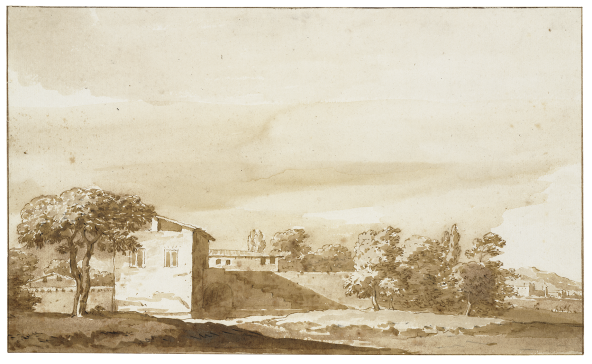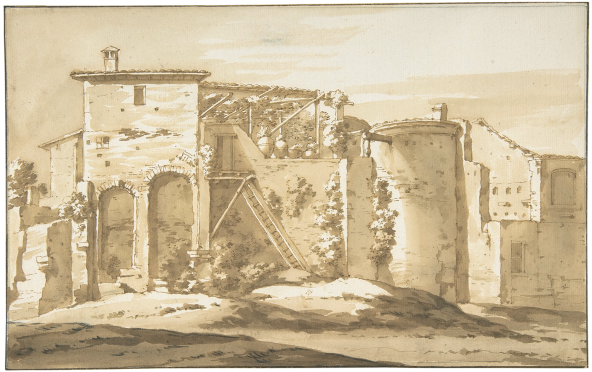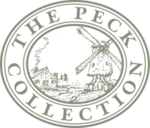Choose a background colour
Jacob van der Ulft, Dutch, 1627-1689: Walls of an Italian Town in a Hilly Landscape, c. 1680
Black chalk and brown wash on paper; framing lines in brown ink.
8 × 12 15⁄16 in. (20.3 × 32.9 cm)
- Chain Lines:
- Horizontal, 24 – 26 mm.
- Watermark:
- Countermark LM. Blue-paper backing sheet from the Baron van Hardenbroek album with D&C Blauw watermark.
- Provenance:
The Van Hardenbroek family, probably Gijsbert Carel Duco, Baron van Hardenbroek, 1769 – 1851, Driebergen; by descent to Ernest Louis, Baron van Hardenbroek van Lockhorst, 1829 – 1877, Randenbroek; possibly sale, Van Huffel, Utrecht, 1928?; dealer, De Kruyff, Zeist, 1981 – 82; Hans van Leeuwen, 1911 – 2010, Amerongen (Lugt 2799a, stamp on verso); his sale, Christie’s, Amsterdam, 24 November 1992, lot 197; Sheldon and Leena Peck, Boston (Lugt 3847); gift to the Ackland Art Museum, inv. no. 2017.1.81.
- Literature/Exhibitions:
F. Robinson in Chapel Hill, Ithaca & Worcester 1999 – 2001, 98 – 99, no. 32.
- Ackland Catalogue:
- 2017.1.81
Using dynamic lighting effects, achieved with various tones of diluted ink contrasted with the white of the paper, Jacob van der Ulft convincingly places the viewer just outside an Italian town or villa on a sunny day. Although the scene provides an overall impression of traveling through the Roman countryside, the likelihood that the artist drew it from life is slim. Questions remain about Van der Ulft’s travels south, especially because he was known to copy Italian views from prints and drawings by other artists. The collection of architectural elements portrayed here suggests Van der Ulft conjured the view entirely from his imagination.
Jacob van der Ulft spent the majority of his career in his native city of Gorinchem in South Holland, where he served in a number of important civic and political positions in the 1660s and 1670s, including as mayor (burgemeester).1
The style, technique, and subject matter of his drawings frequently resemble those of the noted amateur artists Jan de Bisschop (1628 – 1671) and Constantijn Huygens II (1628 – 1697). Even today, confusion occasionally persists in distinguishing these artists’ drawings from Van der Ulft’s, especially those of De Bisschop (a difficulty noted as early as 1821 by Christiaan Josi), and exacerbated by Van der Ulft’s practice of copying De Bisschop’s compositions.2
While no personal connection with De Bisschop can be firmly established, it seems likely that they knew each other. We know that Van der Ulft was on familiar terms with the Huygens family, with letters revealing that Contantijn’s brother Christiaan attempted to serve as a kind of agent-dealer of Van der Ulft’s artworks in Paris in 1666, and that Lodewijk Huygens was responsible for installing Van der Ulft as mayor of Gorinchem during the quelling of anti-Orangist sympathies there in the early 1670s.3
These relationships are worth emphasizing because Van der Ulft is often, and misleadingly, lumped together with these highly placed courtiers as a fellow dilettante whose main occupation was that of politician. On the contrary, his trade background and prolific output in a variety of media, as well as documented commissions, suggest that he was frequently (if not always primarily) an artist by profession, one engaged in the actual business of making paintings, drawings, prints, and stained-glass windows. He likely trained as a glazier with his father. Despite the fact that none of his windows are known today, Arnold Houbraken (1660 – 1719) remarkably called him the foremost glass painter of the century.4
He is also listed as an architect in a 1659 document, which is interesting in light of the many inventive capriccios that he both painted and drew of ancient Roman or Roman-like architecture.5
The present drawing is more prosaic than most of Van der Ulft’s studies of buildings, which commonly feature grander and obviously classical architecture, whether invented or real. We appear to be standing just outside the walls of a town on a tranquil day in an untroubled part of the countryside. It bears comparison to a drawing in the Teylers Museum that furnishes a similarly placid view of a villa on the outskirts of a fortified town with substantial walls seen in the distance to the right Fig. 59.1.6

Jacob van der Ulft, Hilly Landscape with a Roman Villa. Pen and brown ink, brown wash, over traces of black chalk, 177 × 292 mm. Haarlem, Teylers Museum, inv. no. q*35.
Teylers Museum, Haarlem, The Netherlands
Though slightly smaller, the Teylers sheet bears a watermark identical to that of the Peck drawing, and the stylistic similarity further suggests that it could have been made around the same time. Several other drawings by Van der Ulft also situate the viewer just outside a town or villa, though sometimes from a slightly farther vantage point and offering a wider prospect of the whole.7
The overall impression is one of travel or a journey through the Roman campagna, although without quite enough uniformity to suggest a planned series, such as the group of twenty-eight Dutch castle ruins that Van der Ulft drew in the early 1660s.8
Such views raise the long-pondered question of whether or not Van der Ulft actually visited Italy. Despite Houbraken’s wonderment at the naturalness of Van der Ulft’s Italian subjects, he averred that the artist had never been to Rome, and noted that such views could have been taken from prints and drawings.9
Modern scholarship tends to concur with Houbraken’s assessment.10
Lending weight to the argument that he never went to Italy is the fact that Van der Ulft was an avid copyist, as his several known replicas of De Bisschop’s drawings attest. A further complication is that De Bisschop also probably never went to Italy himself, likewise taking his views from others.11
De Bisschop, however, had access to major collections of drawings in the hands of noted liefhebbers (art lovers), as he stated himself in one of the dedicatory prefaces of his Icones, from which he could have taken some of his views that Van der Ulft later copied.12
There is also some speculation that Van der Ulft came into possession of a large number of De Bisschop’s drawings after the latter’s death in 1671.13
Although this is not the type of famous Roman ruin or scene that artists tended to copy, the unassuming nature of the present work does not preclude that there was a prototype by another hand. Van der Ulft’s charming View of an Osteria Fig. 59.2, for example, similar in style and format, appears to have been taken directly from a drawing by Willem van Nieulandt II (1584 – 1635).14

Jacob van der Ulft, An Osteria in the Campagna. Graphite, pen and brown ink, brush and brown wash, 185 × 296 mm. New York, Metropolitan Museum of Art, inv. no. 1994.59.
The Metropolitan Museum of Art, New York. Gift of Mr. and Mrs. Jimmy J. Younger, 1994
It is also possible that Van der Ulft generated the present work entirely from his imagination, much like his capriccios. The apparent looseness of the architectural agglomeration here argues for a purely invented work. Whatever the case, Van der Ulft managed to convey dynamic lighting effects in a remarkably convincing manner by using a wide range of tone, as well as the white reserve of the paper. He also used black chalk, not just to set down the initial design, but also as an integral element of the final composition, limning certain architectural elements (such as the tower, chimney, and house in the upper left) in a bright yet subtle manner against the sky. He often used pen for such outlines, but the chalk in this case creates a more natural impression. While the dating of Van der Ulft’s drawings has long been difficult, this work appears to accord with others the artist inscribed with dates in the 1670s.15
This sheet comes from an album of sixty-three drawings by Van der Ulft that was either assembled by or came into the possession of the Barons van Hardenbroek, which was mentioned for the first time by Kramm in 1863.16
A group of fifty-eight of these drawings remains together in the Fondation Custodia, Paris, but the Peck drawing came from a smaller group, perhaps from the same album, that was sold separately in 1992 (which included the aforementioned Osteria in New York).17
The present drawing is one of the few to retain the blue-paper backing sheet from the Hardenbroek album, and bears a watermark dating circa 1770, thereby offering what might be a reliable notion of when the album was assembled.
End Notes
For an overview of the Van der Ulft’s life and career, see Tissink & De Wit 1987, 33 – 57.
Josi 1821, unpaginated (under Van der Ulft); Tissink & De Wit 1987, 38 – 39; and Jellema & Plomp 1992, 16 – 17. For specific examples of De Bisschop’s drawings that Van der Ulft copied, see Jellema & Plomp 1992, 28 – 31, nos. 9, 12 – 14. A number of further copies can be found in the Baron van Hardenbroek album of fifty-eight drawings by Van der Ulft in the Fondation Custodia, Paris, inv. no. 6481. Certain caches of drawings in present-day collections still pose problems in terms of distinguishing the hands of De Bisschop and Van der Ulft; see, for example, Jaffé 2002, vol. 3, 350 – 68, nos. 1398 – 441; and Turner & White 2014, vol. 1, 65, no. 23.126.
Tissink & De Wit 1987, 42 – 44.
Houbraken 1718 – 21, vol. 2, 196 – 98.
The 1659 notarial act called him schilder en architak; Tissink & De Wit 1987, 47. For Van der Ulft’s Roman capriccio paintings, see Repp-Eckert 1989. Some of Van der Ulft’s presumed work as a book illustrator has been questioned, for which see Plomp 2006 (reattributing several illustrations to Gerbrand van den Eeckhout).
Plomp 1997, 404, no. 477.
See, for example, the drawings by Van der Ulft in Amsterdam (Rijksmuseum, inv. no. RP-T-1900-A-4428), Dresden (Kupferstich-Kabinett, inv. no. c 1988– 582), Leiden (Universiteitsbibliotheek, inv. no. pk-t-aw-2260), and Paris (Musée du Louvre, inv. no. RF 720).
For a study of Van der Ulft’s reconstructed castle ruin series, see Dumas 2017.
Houbraken 1718 – 21, vol. 2, 197
Tissink & De Wit 1987, 36; and Peter Schatborn in Amsterdam 2001, 199. A few earlier commentators, however, assumed that Van der Ulft had been to Rome; see Hoogewerff 1952, 145; and Kramm 1857 – 64, vol. 6 (1863), 1658 – 59.
Colenbrander 1985; and Schatborn in Amsterdam 2001, 197 – 99. Their mutual friend, Constantijn Huygens II, indeed made the voyage to Rome in 1650, though his diary entries and any drawings that he may have made there do not appear to have survived; see Amsterdam & Ghent 1982 – 83, 14.
See the dedication to Jan Uytenbogaert at the beginning of the second volume of De Bisschop’s Icones (1669); Van Gelder & Jost 1985, 135 – 36.
This idea appears to have been first put forward by Carlos van Hasselt in Brussels, Rotterdam, Paris & Bern 1968 – 69, 154, under no. 150. This idea seems frustrated, however, by the fact that De Bisschop’s studio estate was not auctioned until 1677 (10 February; according to Schatborn in Amsterdam 2001, 199) yet a number of Van der Ulft’s copies are dated 1674 and 1675 (e.g., in the album in the Fondation Custodia, Paris, inv. no. 6481), thus after De Bisschop died, but before the sale of his artworks.
For this likely prototype by Van Nieulandt, see London, Paris, Bern & Brussels 1972, no. 64.
For example, the View of Tivoli, dated 1673, from the Van Regteren Altena Collection (Christie’s, London, 10 July 2014, lot 59); and the three views of Roman villas or structures, all dated 1674, in Frankfurt (Städel Museum, inv. nos. 2883, 2885, 2886).
Kramm 1857 – 64, vol. 6 (1863), 1658 – 59.
See the introduction to the group of Van der Ulft drawings in the sale catalogue of the Hans van Leeuwen Collection (Part I), Christie’s, Amsterdam, 24 November 1992, 106 – 11, lots 190 – 97.
